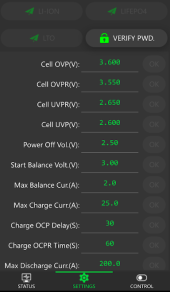Andre Magro
New Member
- Joined
- Jun 16, 2020
- Messages
- 38
Hello,
I'm building a 16 cell (48V) 272Ah battery bank, and yesterday I started to top balancing the first 8 cells.
I'm using JKBMS 24S 2A 200A BT and two benchtop power supplies (30V10A anda 60V5A) with 15A total.
I put the cells in series and the top balance procedure started, btw the "Balance" feature of the BMS was turned on during the top balance.
After aprox 14h the BMS was triggered since "Cell Over Voltage" 3.6V was reached.
And this is what I got:
As we can see 14h later there is a big diference between the cells voltage, but curiously the cells 1,3,5,7 are very close, and cells 2,4,6,8 also.
(the column "4h later" shows the lowest and highest voltage cells)
So, what could happen? Different SOC cells, but why exactly between pair and odd cells?
Should I leave the cells in series so the JKBMS could balance them? Should I connect them in parallel and let them balance?
Edit: add "17h later" column (the cells are settling with BMS "Balance" mode on)
Thanks
I'm building a 16 cell (48V) 272Ah battery bank, and yesterday I started to top balancing the first 8 cells.
I'm using JKBMS 24S 2A 200A BT and two benchtop power supplies (30V10A anda 60V5A) with 15A total.
I put the cells in series and the top balance procedure started, btw the "Balance" feature of the BMS was turned on during the top balance.
After aprox 14h the BMS was triggered since "Cell Over Voltage" 3.6V was reached.
And this is what I got:
| Cell | initial state (V) | 4h later (V) (charging) | 14h later (V) (stop charge) | 17h later (V) (w/Balance:On) |
| 1 | 3.295 | 3.555 | 3.419 | |
| 2 | 3.296 | 3.381 | 3.354 | |
| 3 | 3.295 | 3.549 | 3.419 | |
| 4 | 3.292 | 3.366 | 3.350 | |
| 5 | 3.293 | 3.375 | 3.551 | 3.419 |
| 6 | 3.295 | 3.380 | 3.354 | |
| 7 | 3.295 | 3.544 | 3.419 | |
| 8 | 3.290 | 3.392 | 3.371 | 3.348 |
| Delta Cell | 0.006 | 0.017 | 0.189 | 0.071 |
As we can see 14h later there is a big diference between the cells voltage, but curiously the cells 1,3,5,7 are very close, and cells 2,4,6,8 also.
(the column "4h later" shows the lowest and highest voltage cells)
So, what could happen? Different SOC cells, but why exactly between pair and odd cells?
Should I leave the cells in series so the JKBMS could balance them? Should I connect them in parallel and let them balance?
Edit: add "17h later" column (the cells are settling with BMS "Balance" mode on)
Thanks
Last edited:





